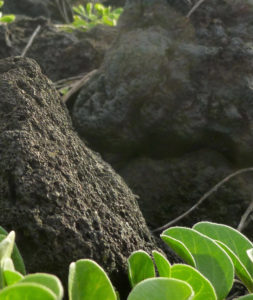
Hawaii’s isolated archipelago straddles the Tropic of Cancer. The Islands’ tropical/sub-tropical location, favorable maritime weather systems and rich volcanic soils are hard to argue with when it comes down to growing tea.
Studying the Islands one soon realizes how difficult it is to generalize about the Hawaiian terroir. In fact it is hard to imagine such a small region that contains such bio-diversity, varied micro-climates and all 11 major soil orders from the desert to the lush tropical forest.
Many of the active volcanoes that created this string of islands in the middle of the ocean are still active. The islands to the north have had more time to settle, cool and develop their rich fertile soils. But down on the Big Island, where the majority of Hawaii’s tea is grown, the map is striped by vast lunar landscapes of fresh lava fields, flowing from the central volcanic peaks down to the sea. As the lava cools, life slowly blows in and lodges into the cracks and crevices and the cycle starts again from scratch. Progressive generations of growth and decomposition slowly produce fresh new topsoil. In extreme contrast, between these rocky flows, are geographically protected patches called “Kipuka” with abundant plant life and rich soil of anything up to four or five meters deep.
Despite their small surface area, the islands are mountainous with large variations in altitude. The highest peak is Mauna Kea on the Big Island, a monumental 13,803 feet (4,207 m) high. So growers in the Volcano Village area are up as high as 5,000 ft. (1,500 m) ASL. As tropical maritime precipitation systems pass over these tall peaks, they tend to burst, due to the rain-shadow effect, on one side of the mountain giving vastly contrasting regions of dry and wet in a very small area. Then from these mountain conditions, it is only a short distance to the warmer coastal gardens that take their weather straight off the ocean.
Naturally the diversity of the terroir requires a good range of cultivars to suit all growing environments. As Hawaii’s burgeoning tea scene slowly evolved after 2000, new seed stock was carefully introduced from China and Japan. Bohea, Yabukita, Yutaka Midori and Benikaori were then followed by other private importations from Darjeeling and Assam cultivars from India and Pakistan and Cing Shin from Taiwan.
With every import of plant material holding the risk of importing tea specific insects and/or diseases, careful control of such imports has been generally respected. As yet Hawaii is relatively pest free compared to most growing regions. As each plot of tea develops, most growers cultivate a variety of these cultivars. Increasing amounts of growers are also opting for a certain amount of seed propagation to strengthen the strains and build reliance.
With such a rich diversity of soils, minerals and micro-climates, the focus of each grower is slightly different. A situation that is complex but full of potential for the development of new and original teas.
For more terroir reports around the world, subscribe to Tea Journey today!
Tea Market
Get More Value from Your Tea: BRU Maker One
+41794574278
Jacque's Organics
(647) 804-7263